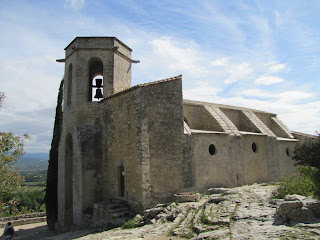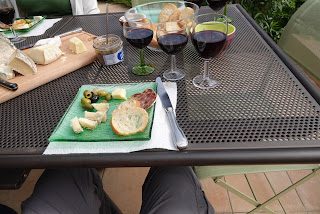Our aim is 4 perched villages - that is, villages clinging to the side part-way up the Luberon massif. These are Oppède, Ménerbes (made famous as the home of Peter Mayle, author of "A Year in Provence"), Lacoste, and Bonnieux.
I went with although scaling steep, narrow, cobbled streets is not really within my repertoire on my chariot. But I have my cross-stitch to entertain me at the bottom of the towns.
The drive took about an hour, leaving after a hearty breakfast of farm-fresh eggs, croissants (of course) and sweet melon. I will try to do a post later about the agriculture of this region. We passed endless fruit orchards, plastic greenhouses, and fields with plastic-covered rows of stuff growing under the plastic. We're not sure what. This area is famous for its fruits and vegetables and feeds much of France on its harvests. The first (of 4) hay cuttings is in and baled. We see small groups of people (6-ish) working in various vineyards.
The morning sun was warming the stones of Oppède when we arrived.
 |
| this man was watching the action on the square out his window |
 |
| roses on the house across from where I was sitting |
 |
| café on the square where I waited |
Up top, the sights were what we've come to expect. Wide vistas....
....a church....
....and a castle.
Next stop, the cork-screw museum in Ménerbes.
 |
| the museum is in a winery |
 |
| the winery in Ménerbes |
 |
| Dave liked this poster for the wine museum. I wonder why. |
Now Ménerbes itself is a one-star perched city famous as the home for British author and ex-pat, Peter Mayle. Our esteemed sommelier, Clark, needs to see this museum that houses 12,000 corkscrews in glass cases. The museum, just outside of town, is located in the Domaine de la Citadelle, a winery, whose wines we didn't taste. (We have quite a supply right now).
But we did eat our lunch on picnic tables with a view to their vineyards. Lovely place to have lunch. Only a bottle of wine would have improved the ambiance. But as we're driving, we'll need to save that for later once we get home.
 |
| first picnic table we've had for lunch |
 |
| our lunch view |
Then we dove into Ménerbes, a plus beau village. This town stretches along it's massif giving expansive views to the valleys on either side of it. At one end is a church (not open) and cemetery and at the other end houses cling together on the lower slope before it flattens out at the top. With help from Dave when the street gets too steep, I was able to explore the entire town with him. This town has been "spruced up," most likely due to its recent popularity.
 |
| the town's medieval bell tower clings to the cliff like these houses do |
 |
| view out from the upper village |
On the way to the 16th century church, we passed the town bell tower.
 |
| the bell tower |
 |
| Now that's a narrow road in an old town |
Originally a Catholic town, it was taken by 150 Protestants in 1573 who were able to hold out until 1578 against a siege from by the Catholics under Pope Pius V. After that, its history was pretty quiet. In the 20th century, it attracted artists and writers and has remained a calm town every since.
On to Lacoste. We're getting worn out with perched villages, so this time we aim right for the top - the ruined château.
 |
| Pierre Cardin owns the remains of the Château du Marquis de Sade |
 |
| what's left of the castle |
Again, the views are spectacular.
 |
| looking toward Bonnieux |
This castle belonged to the Marquis de Sade in the 18th century. He had run-ins with the police over local women and was eventually imprisoned. The château was partially ruined and looted in the late 18th century. It is now owned by Pierre Cardin and hosts local events. Besides the views, there are large pieces of metal sculpture gracing the entrance.
 |
| sculpture of the Marquis de Sade - modern of course |
My favorite is the profile of the Marquis de Sade over the entrance.
 |
| Profile of Marquis de Sade at the entrance |
We headed toward Bonnieux and are stopped by a deviation, detour and must go back the way we came. That's OK, because we saw a sign for a dolmen. We haven't yet seen a dolmen here, so we're happy to make the detour. However, this is what we saw.
How do they know it's a dolmen? It just looks like a rock, Did they excavate and then rebury the thing? Zero points for having a dolmen in Provence in our opinion.
Last stop was Bonnieux. Clark bought a bell that he was told was made in Bonnieux, so he was keeping an eye out for a bell maker. No luck. With huge effort on his part, Dave provided extra horsepower to get my chariot up a steep hill into the old city.
We even had to take it apart to carry it around a truck that was completely filling the road and most of the walkway. Once up to the Place de la Liberté, we found that getting up to the church required more climbing and steps. I gave up, found my way back down to the car and did some cross-stitch while waiting for the team to finish up above. I was told I didn't miss much.
Having scaled to the tops of 4 perched villages in one day, we took our leave of the Luberon and headed home.
Tonight's aperos, on the patio, featured a three-way tasting between Châteauneuf-du-Pape, Vacquéras, and the Hermitage we bought yesterday.
The Châteauneuf won, but perhaps only because we deemed the Hermitage to still be young and a bit rough. All were well worth drinking and of pretty close quality. It all came down to the fruitiness and complexity of the Châteauneuf over the others.











No comments:
Post a Comment